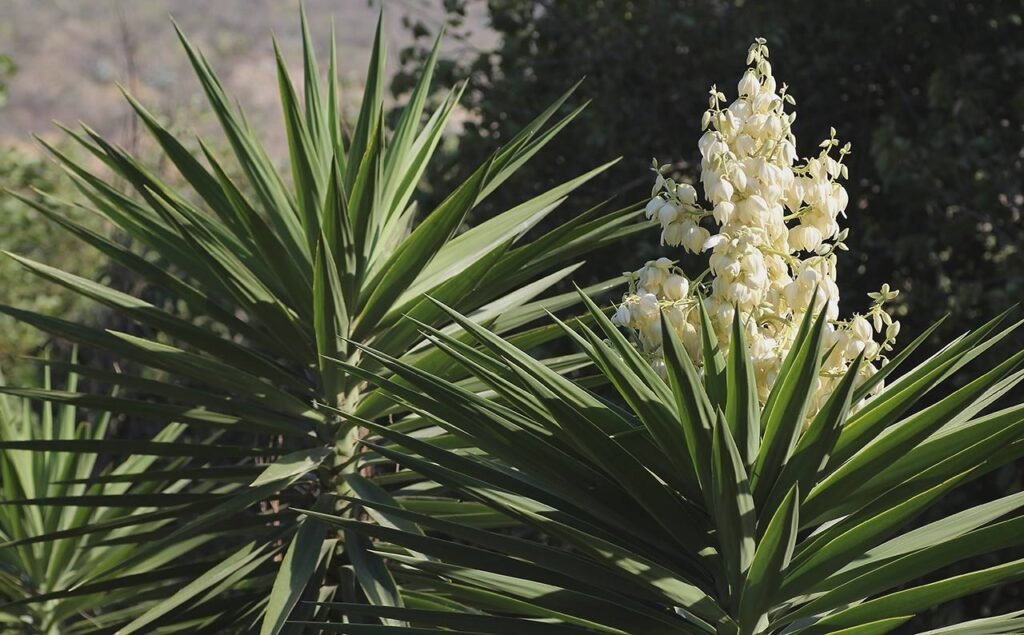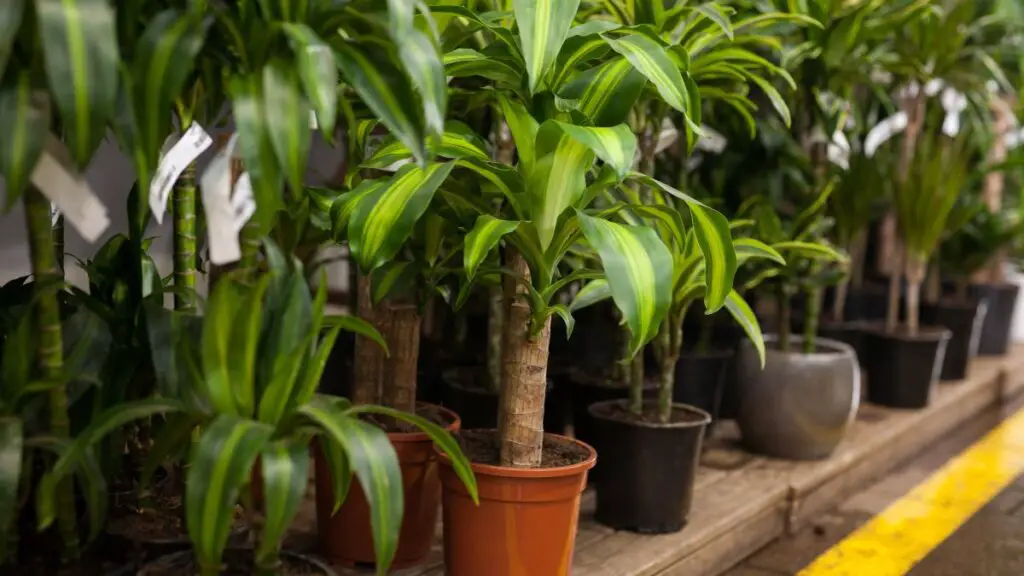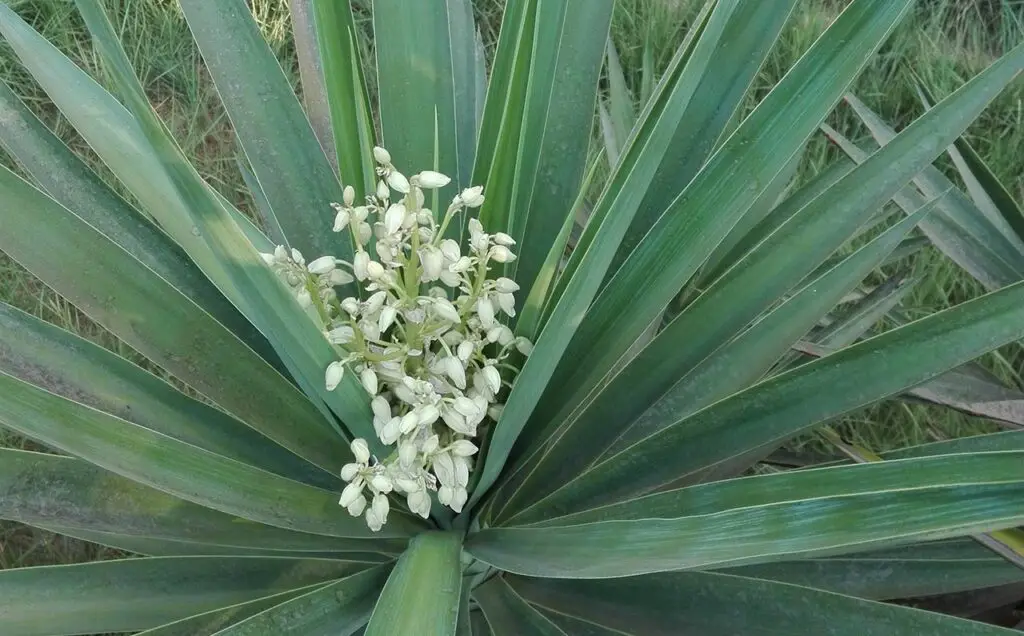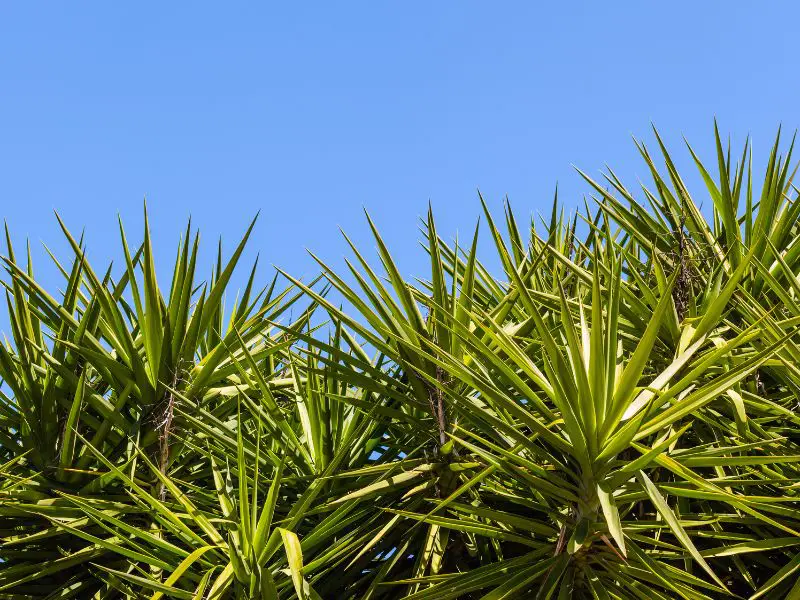Spineless Yucca: Care, Growth, and Propagation Guide
If you’re not familiar with the Spineless Yucca, also known as the Yucca elephantipes or Yucca gigantea, you’ve actually probably seen this bad boy around.
It’s a stunner with tall, cane-like stems and gorgeous, sword-shaped leaves.
And the best part? It’s practically indestructible.
This tough-as-nails plant is perfect for all you folks out there who are juggling a million things and still want to maintain that indoor jungle vibe.
Interested? We got all the deets of caring for this plant, its growth habits, and some tips and tricks for propagating it.
Why the Spineless Yucca Plant?
When it comes to versatile and hardy houseplants, the spineless yucca definitely stands out.
I’ve seen so many people choose this plant because of its easy-care nature and striking appearance.
Wanna know what makes spineless yucca such a great plant?

Spineless yucca (Yucca elephantipes) is known for its long, sword-like leaves and tall, cylindrical trunk.
It’s a native of Mexico and Central America, and it’s no surprise that this plant can adapt to a wide range of growing conditions.
In the wild, spineless yucca can grow up to 30 feet tall, but don’t worry—when grown indoors, it stays at a more manageable 6 to 10 feet.
Here are a few key aspects of spineless yucca to keep in mind:
- Light: Spineless yucca loves sunlight and can tolerate both direct and indirect light. It’ll appreciate a south-facing or west-facing window.
- Water: Allow the soil to dry out between waterings—overwatering can be detrimental. Water it about once every two weeks in the summer and once a month in the winter.
- Temperature: This plant can handle temperatures from 60 to 90°F, but it’s best to avoid sudden temperature changes.
- Fertilizer: To promote growth, feed your spineless yucca a balanced, water-soluble fertilizer. Less is more—apply it once or twice during the growing season.
Pests or diseases usually don’t bother spineless yucca, but keep an eye out for common issues like yellowing leaves which could indicate overwatering, or brown tips which might mean your plant needs more humidity.
In terms of repotting, you won’t have to do it too often.
Spineless yucca has a pretty slow growth rate, so repotting every 2 to 3 years is usually enough.
When choosing a pot, go for one that’s sturdy and has good drainage to prevent waterlogged roots.
Ideal Growing Conditions for a Healthy Spineless Yucca Plant
When it comes to growing a beautiful and robust spineless yucca, I’ve learned that there are a few key conditions to keep in mind.
Once you’ve got these down, you’ll be on your way to having a thriving, low-maintenance houseplant that’ll brighten up any space.
Light Needs
When it comes to light requirements, spineless yuccas love bright, indirect sunlight.
A spot near a window with filtered light is perfect, but they can also tolerate lower light levels.
Just make sure they don’t get too much direct sun, as it can burn their leaves.
Temperature Needs
Temperature-wise, these plants prefer a range between 65-75°F (18-24°C) during the day, and a slightly cooler 55-65°F (13-18°C) at night.
They aren’t big fans of sudden temperature changes, so keep them away from drafts or heating vents.
Here’s a quick table to summarize these temperatures:
| Time of Day | Ideal Temperature Range |
|---|---|
| Daytime | 65-75°F (18-24°C) |
| Nighttime | 55-65°F (13-18°C) |
Watering Needs
Spineless yuccas like their soil fairly moist, but not soaking wet.
You’ll wanna let the top couple inches of soil dry out between waterings.
Overwatering can lead to root rot, and nobody wants that!
Soil Needs
Another crucial factor is soil type:
- Well-draining soil is a must.
- Mix peat moss, sand, and dense soil in equal parts for the perfect combo.
- Make sure your pot has drainage holes to prevent standing water.
Fertilizing Needs
Don’t forget to fertilize your spineless yucca. Here’s what you need to know:
- Use a balanced liquid houseplant fertilizer (like a 10-10-10 or 14-14-14).
- Fertilize every two weeks during the growing season (spring and summer).
- Cut back to every six weeks in the dormant season (fall and winter).
Pruning Needs
Spineless yucca plants don’t need much pruning.
But if your plant is getting too tall or leggy, you can trim it back.
Just make clean cuts above a leaf or lateral branch, and you’re good to go.
Differences Between Spineless and Traditional Yucca
When we’re talking about yucca plants, it’s essential to know the differences between spineless and traditional yucca.
We’ve got a quick rundown of their unique features so you can choose the perfect one for your home or garden.
Spineless yucca, also known as Yucca elephantipes or Yucca gigantea, is known for its lack of sharp spines on the leaves.

Some key characteristics of spineless yucca include:
- Smooth, flexible leaves with no spines
- Faster growth rate than traditional yucca
- Can withstand lower light conditions
- Less hardy when it comes to temperature extremes
Now, let’s take a look at traditional yucca.
There are multiple species that fall under the category of traditional yucca, but some of the more common ones are Yucca filamentosa and Yucca aloifolia.
Here are a few features you’ll likely find in traditional yucca plants:
- Pointed, stiff leaves with sharp spines
- Slower growth rate
- Tolerant of a wider range of light conditions
- More resistant to temperature changes
To give you a better understanding of the differences between the two types, here’s a comparison table:
| Feature | Spineless Yucca | Traditional Yucca |
|---|---|---|
| Leaves | Smooth, flexible | Pointed, stiff, spiny |
| Growth rate | Faster growth rate | Slower growth rate |
| Light Conditions | Lower light tolerance | Wider light tolerance |
| Temperature Resistance | Less hardy | More resistant |
If you’re looking to add a yucca plant to your indoor space, a spineless yucca might be your best bet.
It’s better suited for low light conditions and has a faster growth rate.
Because of its smooth, spine-free leaves, it’s also a lot safer – particularly for homes with children or pets.
On the other hand, traditional yucca varieties can be ideal for outdoor gardens or areas with abundant sunlight.
They’re more resistant to temperature changes and boast that classic, spiky appearance that many growers appreciate.
Propagation Techniques for Success
When it comes to propagating spineless yucca, I’ve found several methods that work well.
These techniques can set you up for success in growing this tropical beauty, whether you’re a beginner or a seasoned houseplant enthusiast.
Cuttings tend to be the easiest method to propagate spineless yucca.
To take a cutting, you’ll want to:
- Choose a healthy stem
- Cut at least 3 to 4 inches in length
- Remove the lower leaves
- Let the cut end dry out for a day or two
- Plant the cutting in well-draining soil
- Water regularly until roots establish
Another option is air layering, which involves creating a new plant while it’s still attached to the parent plant.
It’s a bit more involved, but I’ve had good results with this technique.
Here’s what you’ll need to do:
- Find a healthy stem and make an upward 1-inch cut
- Insert a small piece of wood or toothpick into the cut to keep it open
- Wrap the cut area in damp sphagnum moss
- Cover the moss with plastic wrap to keep it moist
- Secure the plastic wrap with tape or twist ties
- Wait 4 to 6 weeks for roots to form
- Remove the new plant from the parent and pot it up in well-draining soil
For the last option, seed propagation can be done if you’re up for a challenge.
Spineless yucca doesn’t produce seeds very often in cultivation, but if you’re lucky enough to find some, follow these steps:
- Soak the seeds for 24 hours to soften their outer coating
- Plant the seeds in a well-draining soil mix
- Keep the soil consistently moist, but not soggy
- Maintain a temperature around 70°F
- Seeds should germinate in 3 to 4 weeks, but be patient – it can take longer
Each of these propagation techniques has its pros and cons, so it’s worth trying them all out to see what works best for your spineless yucca.
You gotta watch out for common issues like overwatering and inadequate light, which can affect the success of your propagation efforts.
Common Pests and Diseases to Watch Out For
When it comes to keeping your spineless yucca healthy, it’s important to keep an eye out for some common pests and diseases that can cause your plant some serious trouble.
Here’s a few of these issues that you might come across.
1. Spider mites
These annoying little critters love to snack on yucca leaves.
They’re super tiny, and you might not even notice them at first, but as their population grows, you’ll see telltale signs like webbing and speckling on your leaves.
Combat them with insecticidal soap or natural predators like ladybugs!
2. Scale insects
You’ll recognize these pesky bugs by the protective coating they create on yucca’s leaves, resembling tiny bumps.
They feed on plant juices, which can weaken your spineless yucca over time.
You’ll wanna take care of them by rubbing them off with a cloth soaked in insecticidal soap or neem oil.
3. Mealybugs
Mealybugs are small, white, and fuzzy, and like to hide in hard-to-reach places on your plant.
They can cause yellowing leaves and overall poor health.
Attack them with a strong stream of water to knock ’em off, and follow it up with some insecticidal soap or neem oil.
Common Diseases for Spineless Yucca
Now, onto some diseases you should be aware of:
- Root rot: Overwatering is a big no-no for spineless yucca and can lead to root rot. To prevent it, use a well-draining soil mix and let the soil dry out between waterings. If you notice black, mushy roots, you’ll need to remove the affected parts and repot your plant in fresh soil.
- Leaf spot: Gray or brown spots on your yucca’s leaves could be a sign of a fungal disease. Keep the foliage dry and avoid splashing water on the leaves to prevent it. Fungicides can help treat this issue, but it’s better to prevent it from happening in the first place.
Keep these potential problems in mind, and your spineless yucca has a great chance at thriving.
Nurturing Indoor and Outdoor Spineless Yucca
Thanks to it’s low-maintenance nature, the spineless yucca is a popular choice among houseplant enthusiasts.
But most people don’t have the deets on nurturing these plants—indoors and outdoors—to keep them thriving.

Watering
Watering is a crucial aspect of spineless yucca care. Remember, don’t overdo it!
Yuccas prefer to dry out between watering sessions; I’d suggest every 10-14 days.
Overwatering can cause root rot and kill your plant—bummer!
Light
Spineless yuccas love bright, indirect sunlight.
Though they’re somewhat tolerant of lower light conditions, give ’em that ideal spot near a bright window, and they’ll thank you.
Just avoid direct sun that might scorch their leaves.
If you’re nurturing an outdoor spineless yucca, find ’em a spot with:
- Partial sun or dappled shade
- Well-draining soil
Temperature
Make sure you’re planting your outdoor yucca in a suitable temperature range—they’re hardy in USDA zones 9-11.
Just remember to bring ’em inside if the temperature dips below 50°F (10°C).
Soil
Spineless yucca thrives in a well-draining, sandy mixture.
Here’s what I’d recommend:
- Equal parts cactus mix and perlite
- A dash of coarse sand or fine gravel
Feeling fancy? Add a bit of coconut coir to increase moisture retention and encourage root growth. Just don’t overdo it—we don’t want soggy roots!
Fertilizer
Feeding your spineless yucca is another question: Do they need fertilizer?
They’re not very demanding, but a little TLC won’t hurt.
Just use half-strength liquid fertilizer once a month during the growing season (spring to early fall).
A few extra tips for your indoor yucca:
- Rotate the pot every few weeks to ensure balanced growth
- Wipe down the leaves with a damp cloth to remove dust
Pruning and Maintenance Tips
I know that taking care of your spineless yucca can seem a bit tricky at times, but with a few simple tips, you’ll have this low-maintenance plant thriving in no time.
Pruning your spineless yucca – it’s super important, but also really easy.
I recommend removing any dead or damaged leaves, as well as any offshoots that seem to be crowding the plant’s base.
Just be careful when you’re trimming, and use a sharp pair of clean pruning shears or scissors.
- When cutting off a leaf, make sure to snip it as close to the trunk as possible.
- You’ll wanna keep an eye on new growth during the spring and summer months – that’s when spineless yuccas typically grow the most!
- If your yucca’s getting too tall, it’s totally cool to lop off the top. This’ll encourage growth from the sides and make your plant bushier. Just remember to let the cut surface dry out for a few days before you water it again.
As for maintenance, know that spineless yucca’s a champ when it comes to adapting to various lighting conditions, but it prefers bright, indirect light.
Make sure your yucca gets at least a few hours of sunlight each day.
deets about watering:
- I suggest letting the top half of the soil dry out before giving your yucca a drink. Too much moisture can lead to root rot and other fungal issues.
- Generally, you’ll be watering your yucca less frequently in the cooler months, as it’s a bit dormant during that time.
Your spineless yucca will be happy in temperatures ranging from 60°F to 75°F.
Just don’t place it near any heat or AC vents – that’ll be super uncomfy for your plant buddy.
Use a liquid houseplant fertilizer at half strength during the growing season (spring and summer).
No need to fertilize in fall or winter – your yucca’s just chillin’ during that time.
Uses and Benefits of the Spineless Yucca
When it comes to versatile houseplants, spineless yucca deserves a spot in the limelight.
It’s not just an eye-catching addition to your indoor décor, but also boasts numerous benefits.
First and foremost, spineless yucca is super low-maintenance.

It thrives in various conditions, from full sun to low light, and doesn’t demand much attention.
You don’t need to be a gardening expert to keep this plant happy – just water it when the soil’s dry, and you’re good to go.
Spineless yucca also adds a tropical vibe to your home, thanks to its lush, arching leaves.
It can grow up to 8 feet tall, turning any room into a mini-jungle.
Plus, this houseplant is pretty resilient – it’s resistant to common pests, so you won’t have to worry about pesky critters nibbling on your precious plant.
Believe it or not, spineless yucca is an excellent air purifier.
According to a study done by NASA, it has the ability to remove harmful chemicals like formaldehyde and benzene from indoor air.
Here’s a breakdown of its air purifying prowess:
| Chemical | Removal Rate (%) |
|---|---|
| Formaldehyde | 50-70 |
| Benzene | 60-70 |
By having a spineless yucca around, you can rest easy knowing that you’re breathing in cleaner air.
In addition to its indoor uses, spineless yucca can also be planted outdoors as an ornamental landscape plant.
It’s drought-tolerant and can withstand harsh conditions.
Here are some quick outdoor landscape benefits:
- Hardy in USDA zones 9-11
- Acts as a natural privacy screen
- Creates a tropical-looking, low-maintenance landscape
Its leaves have some surprising uses too.
The fibrous strands in its leaves can be utilized to make ropes, mats, or even baskets!
It’s no wonder that indigenous cultures and clever DIY-ers appreciate the usefulness of this fantastic plant.
Frequently Asked Questions About Care
I often get asked about the best ways to care for spineless yucca plants.
So, I’ve curated some of the most common questions and their answers to help y’all out.
How much sunlight does it need?
Spineless yucca plants love bright, indirect sunlight.
It’s ideal to place them near a window, but avoid direct sunlight as it can scorch the leaves.
If you don’t have a bright spot, don’t stress – these plants can adapt to lower light conditions, although growth may be slower.
What’s the best watering schedule?
I can’t emphasize enough that overwatering these plants is a big no-no.
Spineless yucca has a low tolerance for wet roots, so letting the soil dry out between waterings is crucial.
Here’s a simple guideline based on seasons:
| Season | Watering Frequency |
|---|---|
| Spring/Summer | Every 1-2 weeks |
| Fall/Winter | Every 2-3 weeks |
What type of soil is best?
A well-draining, sandy soil mix is what you want for your spineless yucca.
Avoid heavy, water-retaining soils as they can cause root rot. A mix of:
- 50% potting soil
- 25% coarse sand
- 25% perlite
Are there any specific fertilizing needs?
Fertilizing spineless yucca isn’t mandatory, but it can help maintain those vibrant green leaves.
During the growing season (spring and summer), I recommend fertilizing every 6-8 weeks with a balanced, water-soluble fertilizer at half-strength.
How do I propagate spineless yucca?
Propagation is super easy! Just follow these three steps:
- Choose a healthy stem and cut a 3-4-inch section with a clean knife.
- Allow the cutting to dry out for a day or two, forming a callus at the cut end.
- Plant the cutting directly in your preferred soil mix, and watch your new plant grow!
Conclusion: Thriving with Your Spineless Yucca
I gotta say, spineless yucca plants are truly the way to go if you’re looking for a low-maintenance, attractive houseplant.
Here’s the key points to keep your spineless yucca thriving in your home.
- Placement: Remember to place your spineless yucca in a spot with a lot of indirect sunlight. They thrive best when they get plenty of sunshine without being exposed to direct rays.
- Watering: Don’t be too generous with the water; it’s important to let the soil dry out a bit between watering sessions. They’re pretty drought-tolerant, so there’s no need to stress about giving ’em too much water.
- Fertilizer: That occasional feed during the growing season won’t hurt. Just keep in mind to use a balanced liquid fertilizer diluted at half strength, and you’re good to go.
- Pruning: Keeping your spineless yucca looking nice and tidy is a piece of cake. Just prune any yellowing or dead leaves, and it’ll reward you with happy vibes and lush growth.
Here’s a quick recap of all the factors that’ll help your spineless yucca thrive:
- Indirect sunlight
- Allowing soil to dry between watering
- Occasional feeding with diluted liquid fertilizer
- Pruning off dead and yellowing leaves
With a little bit of attention to these key factors, your spineless yucca will reward you with its stunning appearance and easygoing nature.
